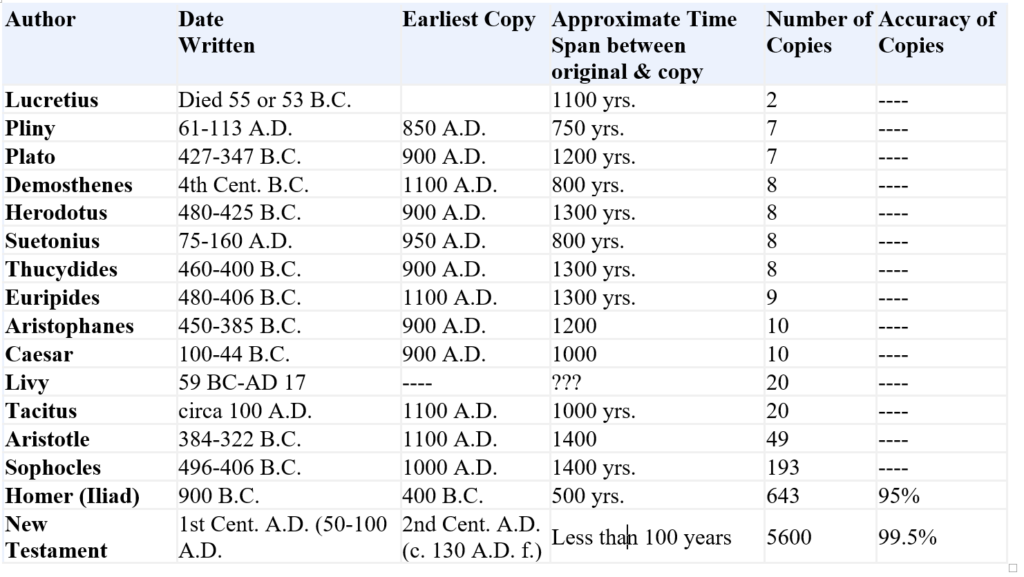By Jon Topping | June 12th, 2021
Many in our culture think of the Bible as being written long after the events they describe. People who believe this usually think that the followers of Christianity elaborated, exaggerated the stories, invented miracles, and made Jesus sound like God.
In a meme quoting David Cross, he jokes about how the Bible has been rewritten and translated many times, required approval by the pope, had kings choosing their favorite parts, and really, he just goes on about how crazy it is that Christians trust the Bible. Basically, it’s like a big game of telephone, where the end result is obviously not going to be the same as the original. But is this really how the Bible came about? Did the original writings get changed over and over again? Are Christians all a bunch of absolute fools for believing in a polluted text that’s been exaggerated and edited over the years? A major problem with these sorts of points (usually made by comedians, or other people without a degree in the subject) is that they merely make jokes, and keep spreading the idea around, without ever actually looking into the facts behind the matter.
When we actually look at the facts, the New Testament is the most reliable ancient historical text in existence, with multiple times more evidence in its favor than any other ancient document. There are many ways to go about evaluating the reliability of the New Testament, but right now, let’s look at the idea David Cross was putting forward, that the Bible is just like a big game of telephone, so it can’t be trusted.
To see whether this is true or not, it’s helpful to actually look at the dates of the copies of the New Testament, how many copies we have, and compare this to other ancient documents that are considered trustworthy.
Altered through copying and translating?
The goal then, is to determine whether the New Testament has been altered through copying and translating.
The big question we want to find out is this: Is the New Testament we have in our hands the same thing that was originally written by the authors?
This question is ultimately answered by looking at the manuscript evidence we have for the New Testament.
As a first point, the issue of the Bible being unreliable because it’s been translated a bunch is absolutely ridiculous. This is because there’s an extremely important detail that completely undermines the whole point; we still have manuscripts in the original language of the text!
I could translate the New Testament from Greek into Latin, then from Latin into German, then from German into Mandarin, then from Mandarin into English. Since we have the original Greek, it’s irrelevant whether it’s been translated many times. It’s not as though when the text got translated they destroyed all the previous versions. So this argument that somehow translating the Bible has made it less reliable is just not worth considering.
Was the Bible edited over the years?
Let’s move on to the real debate, as to whether the Bible was edited over the years. Below there is a chart showing the manuscript evidence of a bunch of ancient documents. At the bottom is the New Testament. Here, you can compare the number of copies we have of the documents, and how much of a time gap there is between when the book was written, and the earliest copies we have.
As you can see, the New Testament has many, many more copies than any of these other ancient texts. This means there are far more copies to compare to each other, so it becomes quite obvious whether the text has been altered or not.
If we have over five thousand copies, and they all say basically the exact same thing (with just the occasional minor spelling error), then there has not been a gradual process of polluting the text with exaggerations.
This fact alone defeats the idea that the Bible was altered over the years, slowly becoming more and more exaggerated, with more and more fairy tales and mythology added to it.
If someone wants to argue that the New Testament was altered, and we do not have what the original authors wrote, then they would need to argue that this alteration of the text happened before all of these copies were written, since they all agree. There’s just one big problem with that; there is very little time between when the New Testament books were written and the earliest copies we have.
If we look at this chart, we can see that our earliest copies of the New Testament books come about less than 100 years after they were written.
Now, in our modern mindset, 80 or so years might seem like a very long time, where a lot could happen to a text. However, by historical standards, that’s incredibly short (just compare it to the others on the chart). Also, given how many copies there were, the copies must have been disseminated all around the world much earlier than this, in order to have this many copies, so we would need to push the date of the supposed alterations back even further. This means that, if the New Testament books were in fact altered, they would have had to have been changed very, very close to the date of when they were written. It’s actually such a small amount of time that it becomes very possible that we have manuscripts of the New Testament books that were copied directly from the original (by regular historical standards, that’s mind blowing for an ancient document).
Given how early our manuscripts are, and the sheer number of copies there are, it becomes next to impossible for there to have been any major alterations in the text.
This chart helps us see another point as well. If we compare the number of copies and the earliest dates of the copies, the New Testament is head and shoulders above all rivals.
Just to clarify, these other ancient texts listed were not cherry picked, where only very unreliable texts were chosen. These ancient documents are some of the best and most reliable texts we have. When historians look at these other documents, there is essentially no debate whether the text we hold in our hands is the same text the original author wrote. In other words, it is not seen as possible that these documents have been highly altered.
Considering the New Testament is far superior in these categories, why then do people challenge the text of the books of the New Testament, and claim they have obviously been tampered with? Why do we hold such an extremely severe standard for the Bible, and then drastically lower that standard for literally every other text? It’s purely because of bias.
The fact of the matter is, when we evaluate the evidence, it becomes quite obvious that the New Testament has not been highly altered. If we consider these other books to be reliable, then we must consider the New Testament to be reliable as well.
Now you may have noticed that all I’ve shown is that the New Testament is reliable, in the sense that the text we have is what was originally written. I haven’t shown that the content of the text is historically reliable, in the sense that we have good reason to think the events the New Testament describes actually happened.
Based on the data we have in terms of manuscript evidence from this chart, we can see that the New Testament has not been altered, regardless of what our comedian friends in the media would have us believe.
There are so many copies that any alterations must have happened way before all the copies were written, and we have copies that are so early, that it becomes next to impossible for major alterations to have snuck in. Also, if we compare the New Testament to other ancient texts that are considered reliable, it is far superior, so we ought to consider it reliable as well.
Interested in learning more?
If you’re interested in learning more about the reliability of the New Testament, my podcast called “Ultimate Questions” dealt with this subject in episodes two through nine. The podcast can be found anywhere podcast are available, or on our Podcast page!
Footnotes:
Chart is from http://carm.org/manuscript-evidence, and was compiled using these three sources:
1) Christian Apologetics, by Norman Geisler, 1976, p. 307.
2) The article “Archaeology and History attest to the Reliability of the Bible,” by Richard M. Fales, Ph.D., in The Evidence Bible, Compiled by Ray Comfort, Bridge-Logos Publishers, Gainesville, FL, 2001, p. 163.
3) A Ready Defense, by Josh Mcdowell, 1993, p. 45.
 Jon Topping is a speaker with Engage International and is based out of Canada.
Jon Topping is a speaker with Engage International and is based out of Canada.





